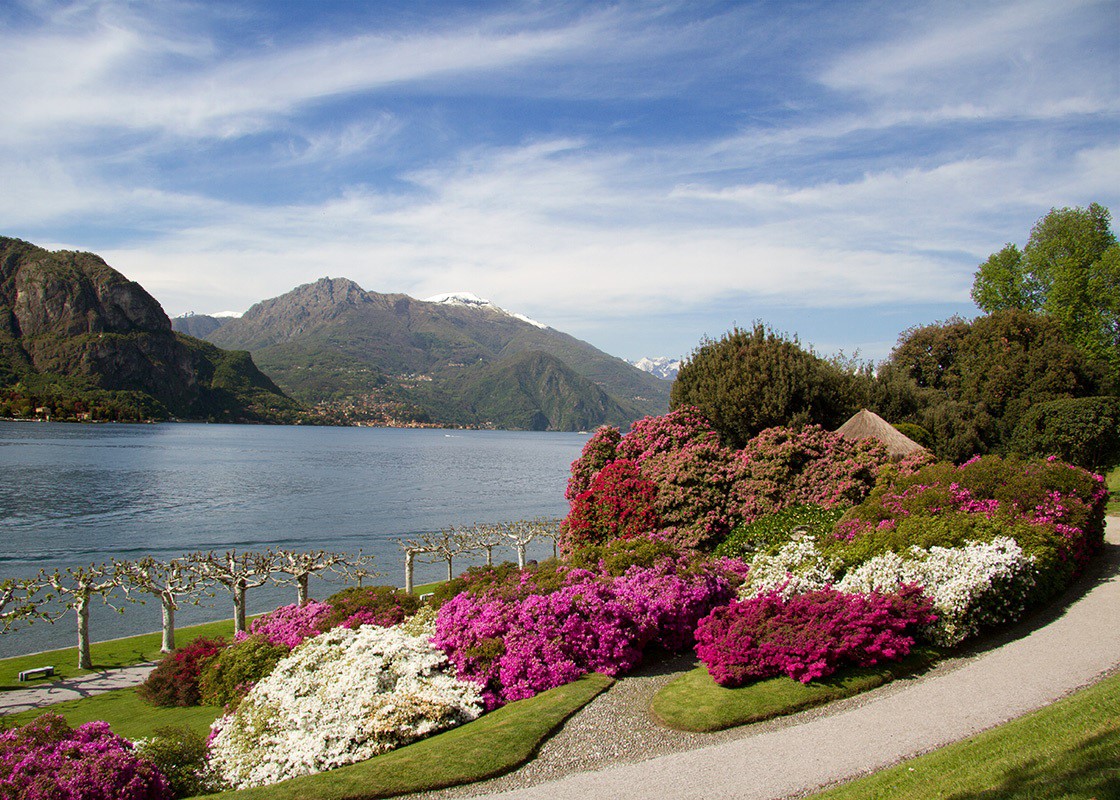
 Italian Botanical Heritage
Italian Botanical Heritage
Italian gardens: Villa Melzi d'Eril, Como Lake
- WTI Magazine #107 Sep 15, 2018
-

 Italian Botanical Heritage
Italian Botanical Heritage
Villa Melzi, located on the eastern shore of Lake Como, was built between 1808 and 1810, in a sober and elegant neoclassical style, designed by the architect Giocondo Albertolli at the request of the Duke of Lodi Francesco Melzi d'Eril, then vice-president of the First Italian Republic and later Grand Chancellor of the Kingdom of Italy, as well as a personal friend of Napoleon. The park was designed by architect Luigi Canonica and agronomist Luigi Villoresi, who also designed the park of the Villa Reale in Monza in the first half of the nineteenth century.
The interiors were decorated and furnished, besides Giocondo Albertolli, by the most important artists of the time, including the painters Andrea Appiani (1754-1817) and Giuseppe Bossi (1777-1815) and the sculptors Antonio Canova (1757-1822) and Giambattista Comolli (1775-1830).
At the end of the nineteenth century the villa and the wonderful park, harmoniously inserted in the lake landscape, admired and described in particular by Stendhal, in his writing "Rome, Naples, Florence" of 1817, passed by inheritance to Duke Tommaso Gallarati-Scotti and later Count Lodovico.
To be absolutely visited are the family chapel, with the altar sculpted by Giambattista Comolli, and the small museum containing some Egyptian and Napoleonic finds.
THE PARK
The garden surrounds the villa, extending along a lope that gently rises from the lake to the top, reachable along winding paths surrounded by exotic plants, azaleas and rhododendrons, trees and marble busts.
Continuing along the way we arrive at the small kiosk now used as a coffee house, a Moorish style building in front of which there is a sculpture by Giovanni Battista Comolli depicting Dante and Beatrice, which seems to have inspired Franz Liszt (1811-1886) in composing the sonata dedicated to the great Italian poet. Inside are the busts of the Austrian Emperor Ferdinand I, the Empress Marianne of Savoy, Duke Lodovico Melzi and his wife Josephine Melzi Barbò, who used to go here to have tea and listen to music.
An avenue with plane-trees (Platanus x hybrida) pruned as an umbrella (a form of breeding coming from France, where it had been adopted along the roads to shade the marching soldiers of Napoleon's army), flanked by a border of azaleas and rhododendrons, runs along the lake shore.
Along the lake and next to a wonderful specimen of pine montezuma (Pinus montezuma) there are some Egyptian statues, from the campaign of Napoleon in Egypt, including one depicting the goddess Pacht.
The avenue leads to a large terrace in front of the villa, whose simple facade is adorned only by a staircase with double ramp, with four lions of Egyptian taste at the base, carved by Giambattista Comolli.
On the terrace overlooking the lake is a boxwood parterre bordered by two columns, around a pool of water lilies adorned with sculptures added in the second half of the 1800s. On the sides, there are two sixteenth-century statues of William of the Gate, depicting Apollo and Meleager.
In the middle of the slope, a grassy surface offers a viewpoint over the lake, up to Villa Carlotta, situated on the opposite bank.
The garden contains a rare example of nineteenth-century terraced greenhouses, almost intact, designed by Luigi Canonica and Luigi Villoresi, in the past heated through the pipes that carried the hot air produced by a boiler located on the lower terrace.
The Orangerie, the greenhouse where citrus plants in pots were once housed during the winter, has instead been used as a small museum of Napoleonic relics, archaeological finds and two Renaissance frescoes.
On the southern side, next to the Loppia docking, we find the family chapel, also designed in neoclassical style by Giocondo Albertolli. Inside there are stuccos with valuable rosettes and frescoes by Angelo Monticelli on drawings by Giuseppe Bossi, the statue of Christ the Redeemer by Giambattista Comolli, and various funerary monuments. On the external wall towards the garden, the door of the Melzi house in Milan has been walled up, attributed to Bramante.
THE PLANTS
The garden has the features of an English-style park, with large patches of rhododendrons and azaleas, many exotic trees now majestic, including Liriodendron tulipifera, Fagus sylvatica 'Asplenifolia', Fagus sylvatica 'Atropurpurea', Gingko biloba, American oaks (Quercus ruber), elms of the Caucasus (Zelkova carpinifolia); evergreens such as cypresses (Cupressus sempervirens), pines (Pinus strobus, P. sylvestris), spectacular bald cypresses (Taxodium distichum), red cedars (Cryptomeria japonica), Sequoia sempervirens, Taxus baccata 'Fastigiata', Cedrus libani, Chamaecyparis obtusa 'Compacta', the camphor (Cinnamomum camphora), evergreens of Sino-Japanese origin perfectly adapted to the climate of the lake, a spectacular Pinus montezumae on the shores of the lake, a large cork (Quercus suber) out of the range, and palms of Chile (Jubaea chinensis).